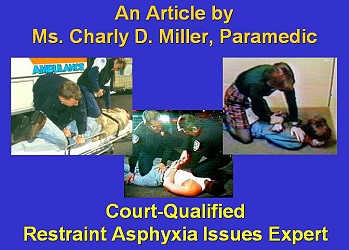

 |
 |
of Frequently Misinterpreted and Misrepresented Restraint Research |

CITATION:
Miller CD.
A comprehensive review of frequently misinterpreted and misrepresented restraint research.
Three parts, posted in February, March, & August, 2005.
http://www.charlydmiller.com/LIB05/2005chasresearchreview.html

ABSTRACT:
Misinterpretation and misrepresentation of research and review articles can have deadly consequences.
At this writing, the three most-frequently misinterpreted and misrepresented restraint-asphyxia-related
research and review articles are:
This review provides concrete support for the following FACTS:

The Comprehensive Review DIRECTORY

 NEW as of FEBRUARY, 2006:
NEW as of FEBRUARY, 2006:
A COLLECTION of Studies Performed By Anesthesiologists
Regarding the Effects of PRONE POSITIONING
On February 6, 2006, I discovered that “Anesthesiologists” have performed and published LOADS of clinical studies consistently documenting the following FACTS:

 NEW as of December, 2005:
NEW as of December, 2005:
A 39-page PDF FILE containing All 3 Parts (& the References) of
A Comprehensive Review of Frequently Misinterpreted
and Misrepresented Restraint Research
If you’re going to PRINT any part of this 3-part Comprehensive Review, print from the PDF file. Webpages end up printing weird (text next to photos bumps the photos to another page, and the like). Plus, printing from the webpages takes up a lot more paper than printing from the PDF file.
The “Webpage” Version: A Comprehensive Review of Frequently
Misinterpreted and Misrepresented Restraint Research; PART ONE
Chan TC, Vilke GM, Neuman T, Clausen JL.
Restraint position and positional asphyxia
Ann Emerg Med, November 1997;30:578-586.
Posted in February, 2005.
The “Webpage” Version: A Comprehensive Review of Frequently
Misinterpreted and Misrepresented Restraint Research; PART TWO
Chan TC, Vilke GM, Neuman T.
Reexamination of custody restraint position and positional asphyxia
Am J Forensic Med Pathol, September 1998;19(3):201-205.
Posted in March, 2005.
The “Webpage” Version: A Comprehensive Review of Frequently
Misinterpreted and Misrepresented Restraint Research; PART THREE
Chan TC; Neuman T; Clausen J; Eisele J; Vilke GM.
Weight force during prone restraint and respiratory function
Am J Forensic Med Pathol, September 2004;25(3):185-189.
FINALLY completed & posted on August 1st, 2005!
The “Webpage” Version: REFERENCES for ALL PARTS of:
A Comprehensive Review of Frequently Misinterpreted and
Misrepresented Restraint Research
FINAL DRAFT Posted in March, 2005.

The “Weight Force” Collection
Eisele JW, Chan TC, Vilke GM, Clausen J.
Comparison of Respiratory Function in the Prone Maximal Restraint
Position With and Without Additional Weight Force on the Back
The abstract of a PAPER presented at the annual meeting of the
American Academy of Forensic Science, in Reno, Nevada: February 21-26, 2000.

Chan TC, Clausen J, Neuman T, Eisele JW, Vilke GM.
Does Weight Force During Physical Restraint
Cause Respiratory Compromise?
The abstract of a PAPER presentation listed in the
Ann Emerg Med, ACEP Research Forum Supplement: pS17, October 2003;42(4).

Chan TC; Neuman T; Clausen J; Eisele J; Vilke GM.
Weight Force During Prone Restraint and Respiratory Function
Am J Forensic Med Pathol 25(3):185-189, September 2004.

Vilke GM, Michalewicz B, Kolkhorst FW, Neuman T, Chan TC. Does Weight Force
During Physical Restraint Cause Respiratory Compromise?
The abstract of a PAPER presented at the 2005 Annual Meeting of the Society for
Academic Emergency Medicine Acad Emerg Med May 2005;12(5 Supplement 1) : page 16.
[The above “presentation paper” was finally published in JAN 2007.
To read CHAS’ Review of that Chan et al report (and obtain a link to its report PDF file), GO TO:
A Comprehensive Review of the January 2007 Chan et al ‘Aggressive Physical Restraint’
Study Report and Questions That Will ‘Defeat’ Those Who Cite It.]


 Email Charly at: c-d-miller@neb.rr.com
Email Charly at: c-d-miller@neb.rr.com